instrument panel SKODA FABIA 2004 1.G / 6Y Owner's Manual
[x] Cancel search | Manufacturer: SKODA, Model Year: 2004, Model line: FABIA, Model: SKODA FABIA 2004 1.G / 6YPages: 247
Page 17 of 247
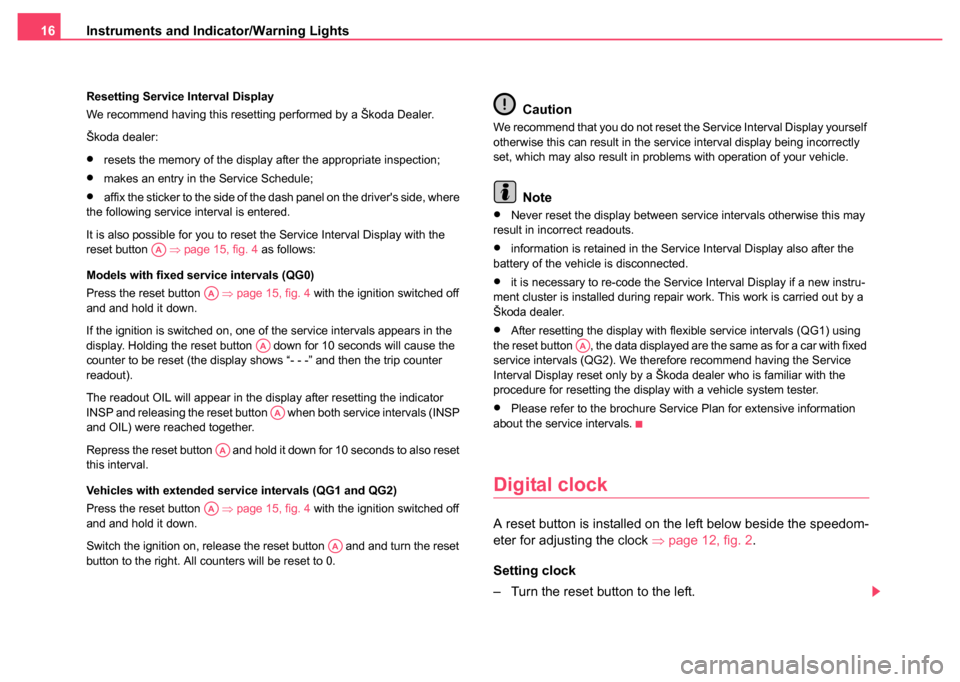
Instruments and Indicator/Warning Lights
16
Resetting Service Interval Display
We recommend having this resetting performed by a ┼Ākoda Dealer.
┼Ākoda dealer:
ŌĆóresets the memory of the display after the appropriate inspection;
ŌĆómakes an entry in the Service Schedule;
ŌĆóaffix the sticker to the side of the dash panel on the driver's side, where
the following service interval is entered.
It is also possible for you to reset the Service Interval Display with the
reset button ŌćÆ page 15, fig. 4 as follows:
Models with fixed service intervals (QG0)
Press the reset button ŌćÆpage 15, fig. 4 with the ignition switched off
and and hold it down.
If the ignition is switched on, one of the service intervals appears in the
display. Holding the reset button down for 10 seconds will cause the
counter to be reset (the display shows ŌĆ£- - -ŌĆØ and then the trip counter
readout).
The readout OIL will appear in the display after resetting the indicator
INSP and releasing the reset button when both service intervals (INSP
and OIL) were reached together.
Repress the reset button and hold it down for 10 seconds to also reset
this interval.
Vehicles with extended service intervals (QG1 and QG2)
Press the reset button ŌćÆpage 15, fig. 4 with the ignition switched off
and and hold it down.
Switch the ignition on, release the reset button and and turn the reset
button to the right. All counters will be reset to 0.
Caution
We recommend that you do not reset the Service Interval Display yourself
otherwise this can result in the service interval display being incorrectly
set, which may also result in problems with operation of your vehicle.
Note
ŌĆóNever reset the display between service intervals otherwise this may
result in incorrect readouts.
ŌĆóinformation is retained in the Service Interval Display also after the
battery of the vehicle is disconnected.
ŌĆóit is necessary to re-code the Service Interval Display if a new instru-
ment cluster is installed during repair work. This work is carried out by a
┼Ākoda dealer.
ŌĆóAfter resetting the display with flexible service intervals (QG1) using
the reset button , the data displayed are the same as for a car with fixed
service intervals (QG2). We therefore recommend having the Service
Interval Display reset only by a ┼Ākoda dealer who is familiar with the
procedure for resetting the display with a vehicle system tester.
ŌĆóPlease refer to the brochure Service Plan for extensive information
about the service intervals.
Digital clock
A reset button is installed on the left below beside the speedom-
eter for adjusting the clock ŌćÆpage 12, fig. 2 .
Setting clock
ŌĆō Turn the reset button to the left.
AA
AA
AA
AA
AA
AA
AA
AA
Page 37 of 247
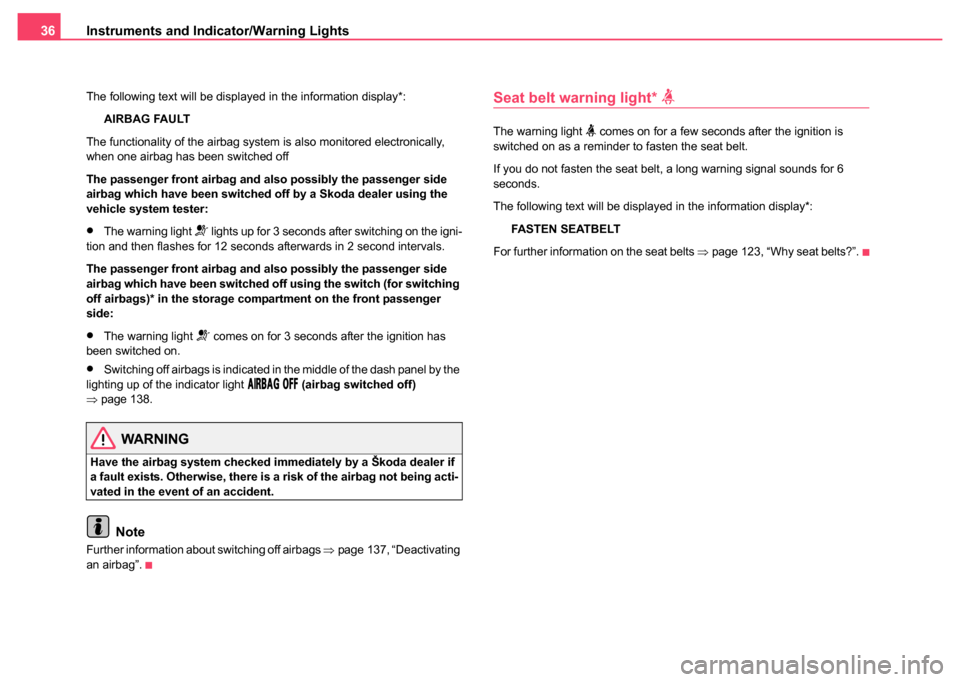
Instruments and Indicator/Warning Lights
36
The following text will be displayed in the information display*:
AIRBAG FAULT
The functionality of the airbag system is also monitored electronically,
when one airbag has been switched off
The passenger front airbag and also possibly the passenger side
airbag which have been switched off by a Skoda dealer using the
vehicle system tester:
ŌĆóThe warning light ’ü┤ lights up for 3 seconds after switching on the igni-
tion and then flashes for 12 seconds afterwards in 2 second intervals.
The passenger front airbag and also possibly the passenger side
airbag which have been switched off using the switch (for switching
off airbags)* in the storage compartment on the front passenger
side:
ŌĆóThe warning light ’ü┤ comes on for 3 seconds after the ignition has
been switched on.
ŌĆóSwitching off airbags is indicated in the middle of the dash panel by the
lighting up of the indicator light ’üü’üē’üÆ’üé’üü’üć ’üÅ’üå’üå (airbag switched off)
ŌćÆ page 138.
WARNING
Have the airbag system checked immediately by a ┼Ākoda dealer if
a fault exists. Otherwise, there is a risk of the airbag not being acti-
vated in the event of an accident.
Note
Further information about switching off airbags ŌćÆpage 137, ŌĆ£Deactivating
an airbagŌĆØ.
Seat belt warning light* ’é¬
The warning light Վ comes on for a few seconds after the ignition is
switched on as a reminder to fasten the seat belt.
If you do not fasten the seat belt, a long warning signal sounds for 6
seconds.
The following text will be displayed in the information display*:
FASTEN SEATBELT
For further information on the seat belts ŌćÆpage 123, ŌĆ£Why seat belts?ŌĆØ.
Page 56 of 247
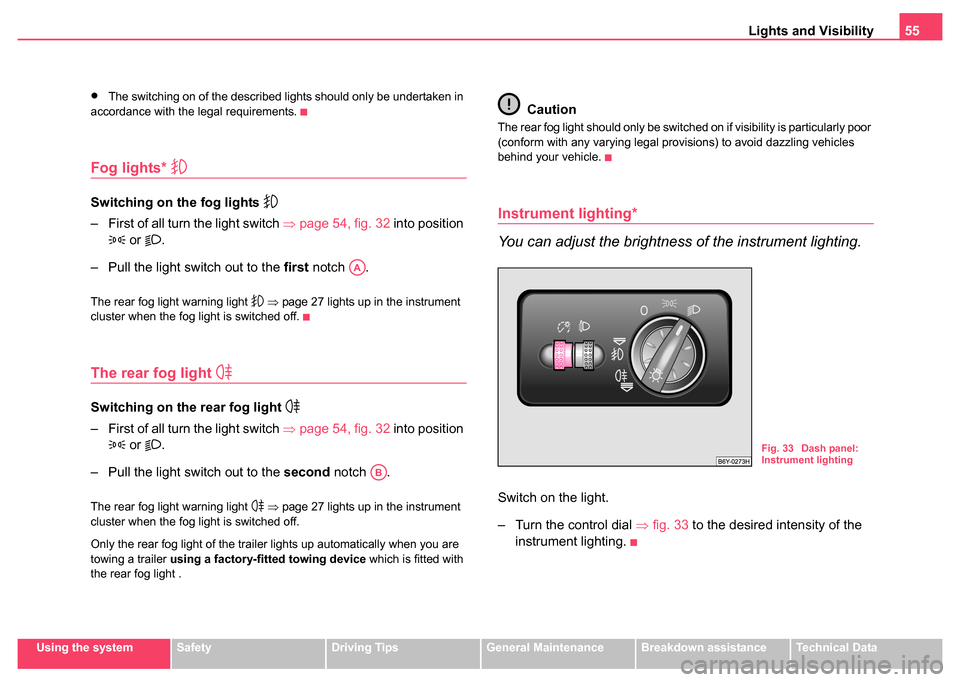
Lights and Visibility55
Using the systemSafetyDriving TipsGeneral MaintenanceBreakdown assistanceTechnical Data
ŌĆóThe switching on of the described lights should only be undertaken in
accordance with the legal requirements.
Fog lights* ’Ć®
Switching on the fog lights ’Ć®
ŌĆō First of all turn the light switch ŌćÆpage 54, fig. 32 into position
’Ć© or ’Ćź.
ŌĆō Pull the light switch out to the first notch .
The rear fog light warning light ’Ć® ŌćÆ page 27 lights up in the instrument
cluster when the fog light is switched off.
The rear fog light ’Ƭ
Switching on the rear fog light ’Ƭ
ŌĆō First of all turn the light switch ŌćÆpage 54, fig. 32 into position
’Ć© or ’Ćź.
ŌĆō Pull the light switch out to the second notch .
The rear fog light warning light ’Ƭ ŌćÆ page 27 lights up in the instrument
cluster when the fog light is switched off.
Only the rear fog light of the trailer lights up automatically when you are
towing a trailer using a factory-fitted towing device which is fitted with
the rear fog light .
Caution
The rear fog light should only be switched on if visibility is particularly poor
(conform with any varying legal provisions) to avoid dazzling vehicles
behind your vehicle.
Instrument lighting*
You can adjust the brightness of the instrument lighting.
Switch on the light.
ŌĆō Turn the control dial ŌćÆfig. 33 to the desired intensity of the
instrument lighting.
AA
AB
Fig. 33 Dash panel:
Instrument lighting
Page 67 of 247
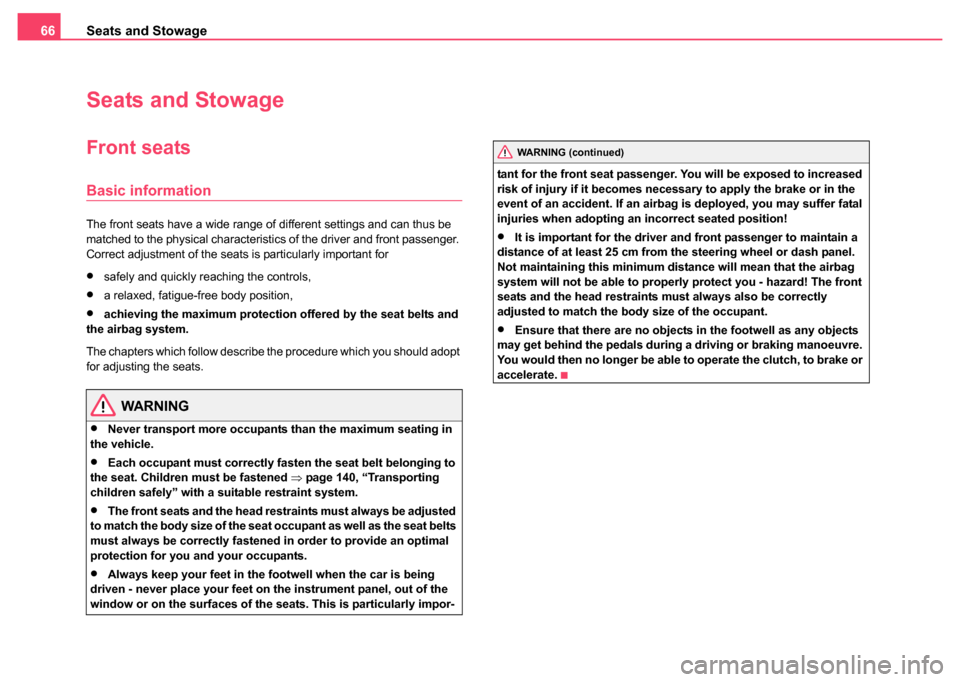
Seats and Stowage
66
Seats and Stowage
Front seats
Basic information
The front seats have a wide range of different settings and can thus be
matched to the physical characteristics of the driver and front passenger.
Correct adjustment of the seats is particularly important for
ŌĆósafely and quickly reaching the controls,
ŌĆóa relaxed, fatigue-free body position,
ŌĆóachieving the maximum protection offered by the seat belts and
the airbag system.
The chapters which follow describe the procedure which you should adopt
for adjusting the seats.
WARNING
ŌĆóNever transport more occupants than the maximum seating in
the vehicle.
ŌĆóEach occupant must correctly fasten the seat belt belonging to
the seat. Children must be fastened ŌćÆpage 140, ŌĆ£Transporting
children safelyŌĆØ with a suitable restraint system.
ŌĆóThe front seats and the head restraints must always be adjusted
to match the body size of the seat occupant as well as the seat belts
must always be correctly fastened in order to provide an optimal
protection for you and your occupants.
ŌĆóAlways keep your feet in the footwell when the car is being
driven - never place your feet on the instrument panel, out of the
window or on the surfaces of the seats. This is particularly impor- tant for the front seat passenger. You will be exposed to increased
risk of injury if it becomes nece
ssary to apply the brake or in the
event of an accident. If an airbag is deployed, you may suffer fatal
injuries when adopting an incorrect seated position!
ŌĆóIt is important for the driver and front passenger to maintain a
distance of at least 25 cm from the steering wheel or dash panel.
Not maintaining this minimum distance will mean that the airbag
system will not be able to properly protect you - hazard! The front
seats and the head restraints must always also be correctly
adjusted to match the body size of the occupant.
ŌĆóEnsure that there are no objects in the footwell as any objects
may get behind the pedals during a driving or braking manoeuvre.
You would then no longer be able to operate the clutch, to brake or
accelerate.
WARNING (continued)
Page 121 of 247
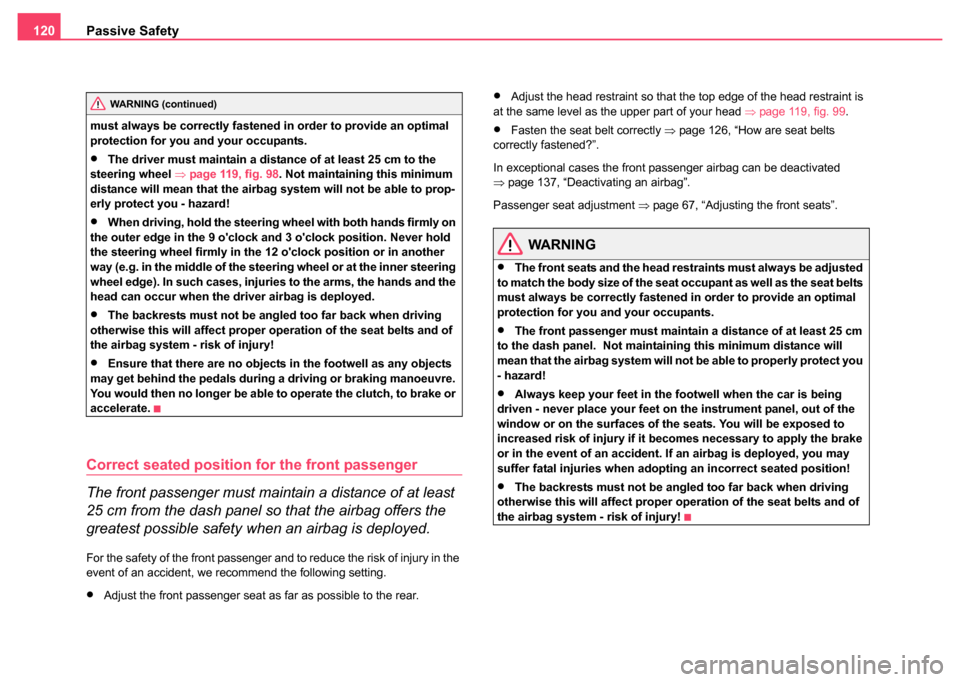
Passive Safety
120
must always be correctly fastened in order to provide an optimal
protection for you and your occupants.
ŌĆóThe driver must maintain a distan ce of at least 25 cm to the
steering wheel ŌćÆpage 119, fig. 98 . Not maintaining this minimum
distance will mean that the airbag system will not be able to prop-
erly protect you - hazard!
ŌĆóWhen driving, hold the steering wheel with both hands firmly on
the outer edge in the 9 o'clock and 3 o'clock position. Never hold
the steering wheel firmly in the 12 o'clock position or in another
way (e.g. in the middle of the steering wheel or at the inner steering
wheel edge). In such cases, injuries to the arms, the hands and the
head can occur when the driver airbag is deployed.
ŌĆóThe backrests must not be angled too far back when driving
otherwise this will affect proper operation of the seat belts and of
the airbag system - risk of injury!
ŌĆóEnsure that there are no objects in the footwell as any objects
may get behind the pedals during a driving or braking manoeuvre.
You would then no longer be able to operate the clutch, to brake or
accelerate.
Correct seated position for the front passenger
The front passenger must maintain a distance of at least
25 cm from the dash panel so that the airbag offers the
greatest possible safety when an airbag is deployed.
For the safety of the front passenger and to reduce the risk of injury in the
event of an accident, we recommend the following setting.
ŌĆóAdjust the front passenger seat as far as possible to the rear.
ŌĆóAdjust the head restraint so that the top edge of the head restraint is
at the same level as the upper part of your head ŌćÆpage 119, fig. 99 .
ŌĆóFasten the seat belt correctly ŌćÆpage 126, ŌĆ£How are seat belts
correctly fastened?ŌĆØ.
In exceptional cases the front passenger airbag can be deactivated
ŌćÆ page 137, ŌĆ£Deactivating an airbagŌĆØ.
Passenger seat adjustment ŌćÆpage 67, ŌĆ£Adjusting the front seatsŌĆØ.
WARNING
ŌĆóThe front seats and the head restraints must always be adjusted
to match the body size of the seat occupant as well as the seat belts
must always be correctly fastened in order to provide an optimal
protection for you and your occupants.
ŌĆóThe front passenger must maintain a distance of at least 25 cm
to the dash panel. Not maintain ing this minimum distance will
mean that the airbag system will not be able to properly protect you
- hazard!
ŌĆóAlways keep your feet in the footwell when the car is being
driven - never place your feet on the instrument panel, out of the
window or on the surfaces of the seats. You will be exposed to
increased risk of injury if it becomes necessary to apply the brake
or in the event of an accident. If an airbag is deployed, you may
suffer fatal injuries when adopting an incorrect seated position!
ŌĆóThe backrests must not be angled too far back when driving
otherwise this will affect proper operation of the seat belts and of
the airbag system - risk of injury!
WARNING (continued)
Page 131 of 247

Airbag system
130
Airbag system
Description of the airbag system
General information on the airbag system
The front airbag system is complementary to the three-point seat belts
and offers additional protection for the head and chest area of the driver
and passenger in the event of a frontal collision.
In the event of a side collision, the side airbags reduce the risk of injury to
the occupants to the part of their body facing the side of the accident.
The airbag system is only functional after the ignition has been switched
on.
The operational readiness of the airbag system is monitored electroni-
cally. The airbag warning light comes on for a few seconds each time the
ignition is switched on.
The airbag system (according to vehicle equipment) essentially
consists of:
ŌĆóan electronic control unit
ŌĆóthe front airbags for the driver and front passenger ŌćÆpage 132
ŌĆóthe side airbags ŌćÆpage 134
ŌĆóan airbag warning light in the instrument cluster ŌćÆpage 35
ŌĆóa front passenger airbag switch* ŌćÆpage 138
ŌĆóan indicator light showing a switched-off front passenger airbag* in the
middle of the dash panel ŌćÆpage 138
A fault in the airbag system exists if:
ŌĆóthe airbag indicator light does not light up when the ignition is switched
on
ŌĆóthe airbag indicator light does not go out after about 3 seconds after
the ignition is switched on
ŌĆóthe airbag indicator light goes out and comes on again after the ignition
is switched on
ŌĆóthe airbag indicator light comes on or flickers when driving
ŌĆóan airbag indicator light showing a switched-off front passenger
airbag* in the middle of the dash panel flashes
WARNING
ŌĆóTo enable the occupants of a car to be protected with the
greatest possible effect when the airbag is deployed, the front
seats must be ŌćÆpage 119, ŌĆ£Correct seated positionŌĆØ correctly
adjusted to match the body size of the occupant.
ŌĆóIf you do not fasten the seat belts when driving, lean too far
forward or adopt an incorrect seated position, you are exposing
yourself to increased risk of injury in the event of an accident.
ŌĆóHave the airbag system checked immediately by a ┼Ākoda dealer
if a fault exists. Otherwise, there is a risk of the airbag not being
activated in the event of an accident.
ŌĆóNo modifications of any kind may be made to parts of the airbag
system.
ŌĆóIt is prohibited to manipulate individual parts of the airbag
system as this might result in the airbag being deployed.
ŌĆóThe protective function of the airbag system is sufficient for
only one accident. The airbag system must then be replaced if the
airbag has been deployed.
ŌĆóThe airbag system needs no maintenance during its working
life.
Page 138 of 247
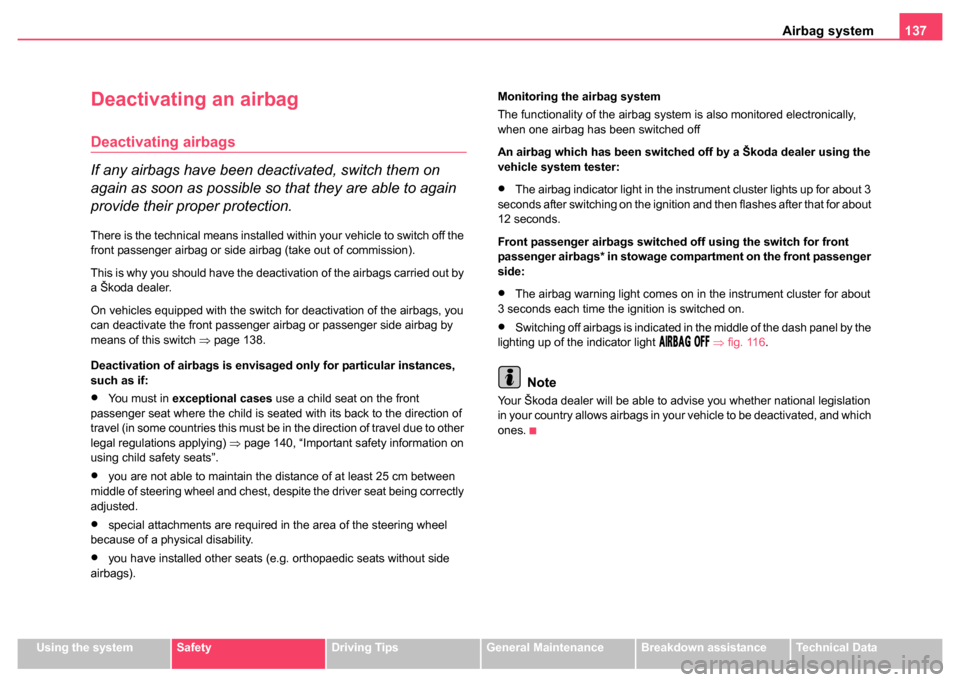
Airbag system137
Using the systemSafetyDriving TipsGeneral MaintenanceBreakdown assistanceTechnical Data
Deactivating an airbag
Deactivating airbags
If any airbags have been deactivated, switch them on
again as soon as possible so that they are able to again
provide their proper protection.
There is the technical means installed within your vehicle to switch off the
front passenger airbag or side airbag (take out of commission).
This is why you should have the deactivation of the airbags carried out by
a ┼Ākoda dealer.
On vehicles equipped with the switch for deactivation of the airbags, you
can deactivate the front passenger airbag or passenger side airbag by
means of this switch ŌćÆpage 138.
Deactivation of airbags is envisaged only for particular instances,
such as if:
ŌĆóYo u m u s t i n exceptional cases use a child seat on the front
passenger seat where the child is seated with its back to the direction of
travel (in some countries this must be in the direction of travel due to other
legal regulations applying) ŌćÆpage 140, ŌĆ£Important safety information on
using child safety seatsŌĆØ.
ŌĆóyou are not able to maintain the distance of at least 25 cm between
middle of steering wheel and chest, despite the driver seat being correctly
adjusted.
ŌĆóspecial attachments are required in the area of the steering wheel
because of a physical disability.
ŌĆóyou have installed other seats (e.g. orthopaedic seats without side
airbags). Monitoring the airbag system
The functionality of the airbag system is also monitored electronically,
when one airbag has been switched off
An airbag which has been switched off by a ┼Ākoda dealer using the
vehicle system tester:
ŌĆóThe airbag indicator light in the instrument cluster lights up for about 3
seconds after switching on the ignition and then flashes after that for about
12 seconds.
Front passenger airbags switched off using the switch for front
passenger airbags* in stowage compartment on the front passenger
side:
ŌĆóThe airbag warning light comes on in the instrument cluster for about
3 seconds each time the ignition is switched on.
ŌĆóSwitching off airbags is indicated in the middle of the dash panel by the
lighting up of the indicator light ’üü’üē’üÆ’üé’üü’üć ’üÅ’üå’üå ŌćÆ fig. 116 .
Note
Your ┼Ākoda dealer will be able to advise you whether national legislation
in your country allows airbags in your vehicle to be deactivated, and which
ones.